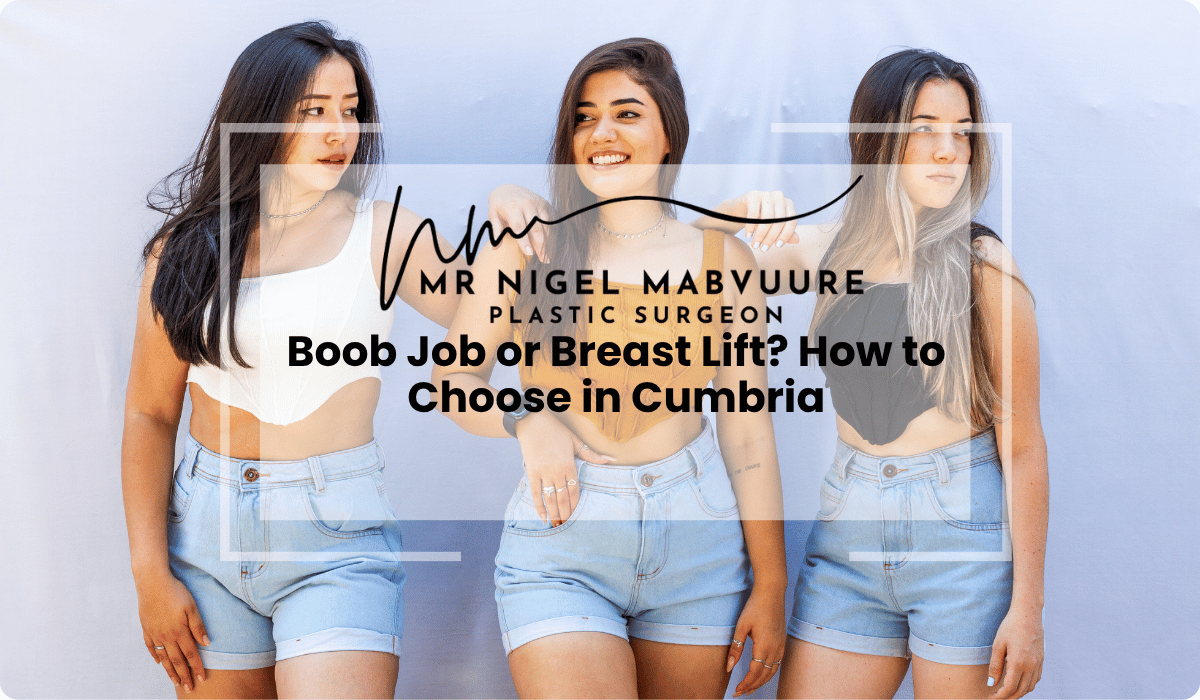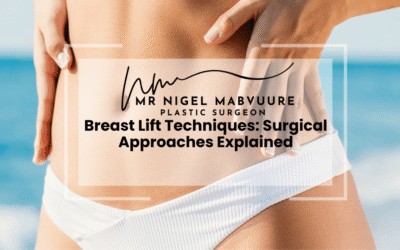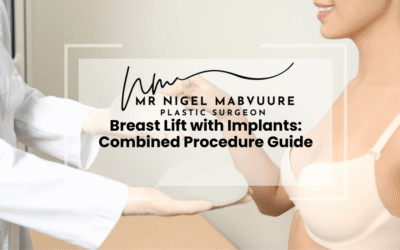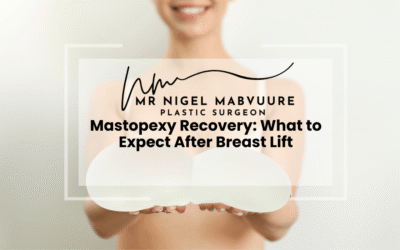- Breast augmentation increases size and volume using implants or fat transfer, while breast lifts address sagging by removing excess skin and repositioning breast tissue.
- Determine which procedure you need by assessing nipple position, degree of sagging, and whether your primary concern is size or position.
- Combined procedures (augmentation-mastopexy) address both volume loss and sagging in a single surgery, though recovery may be more complex.
- Recovery times vary: 1-2 weeks for augmentation, 2 weeks for lifts, and 2-3 weeks for combined procedures, with final results visible after several months.
- In Cumbria, breast augmentation typically costs £4,500-£6,500, breast lifts range from £5,500-£7,500, and combined procedures cost £7,000-£9,500.
- Choose a GMC-registered surgeon with BAAPS/BAPRAS membership and specific experience in breast procedures for optimal results.
Table of Contents
- Understanding Breast Enhancement Options in Cumbria
- Breast Augmentation vs Breast Lift: Key Differences Explained
- How to Determine Which Breast Procedure You Need
- Can You Combine a Boob Job with a Breast Lift?
- Recovery and Results: What to Expect from Each Procedure
- Finding the Right Breast Surgery Specialist in Cumbria
- Cost Comparison: Breast Augmentation vs Lift in Cumbria
Understanding Breast Enhancement Options in Cumbria
When considering breast enhancement in Cumbria, patients are often faced with several options that can seem overwhelming at first. The two most common procedures that women enquire about are breast augmentation (commonly known as a “boob job”) and breast lift (mastopexy). Each procedure addresses different concerns and delivers distinct results.
Breast enhancement surgery has become increasingly accessible in Cumbria, with several qualified plastic surgeons offering these procedures across the region. Whether you’re in Carlisle, Kendal, Whitehaven, or Barrow-in-Furness, understanding your options is the first step toward making an informed decision about your body.
Breast augmentation focuses primarily on increasing the size and enhancing the shape of the breasts using implants or fat transfer techniques. This procedure is ideal for women who are dissatisfied with the size of their breasts or have experienced volume loss after pregnancy or weight fluctuations.
A breast lift, on the other hand, addresses sagging or drooping breasts by removing excess skin and tightening the surrounding tissue to reshape and support the new breast contour. This procedure doesn’t significantly change the size of your breasts but rather improves their position and firmness.
In Cumbria, patients benefit from personalised consultations where surgeons evaluate individual anatomy, discuss desired outcomes, and recommend the most appropriate procedure. The Lake District’s growing reputation for discreet, high-quality cosmetic surgery makes it an excellent choice for those seeking breast enhancement procedures in a more private setting than larger metropolitan areas.
Breast Augmentation vs Breast Lift: Key Differences Explained
Understanding the fundamental differences between breast augmentation and breast lift procedures is crucial when deciding which option is right for you. These distinctions encompass the surgical techniques, intended outcomes, and ideal candidates for each procedure.
Breast Augmentation (Boob Job):
- Primary Goal: Increases breast size and volume
- Technique: Involves placing implants (silicone or saline) or using fat transfer
- Incision Sites: Typically in the inframammary fold (under the breast), around the areola, or in the armpit
- Ideal Candidates: Women with small breasts, asymmetrical breasts, or those who have lost volume after pregnancy or weight loss
- Does Not Address: Significant sagging or drooping of the breasts
Breast Lift (Mastopexy):
- Primary Goal: Raises and reshapes sagging breasts
- Technique: Removes excess skin and tightens surrounding tissue
- Incision Sites: Often more extensive, potentially including around the areola, vertically down to the breast crease, and horizontally along the crease
- Ideal Candidates: Women with pendulous breasts, stretched skin, or downward-pointing nipples
- Does Not Address: Lack of volume or small breast size
The recovery process and scarring also differ between these procedures. Breast augmentation typically results in less visible scarring and a shorter recovery period compared to a breast lift. However, a lift often provides more dramatic improvement in breast shape and position for those with significant sagging.
In Cumbria, surgeons specialising in breast procedures can provide detailed visual examples of previous patients’ results to help illustrate these differences during your consultation. This visual guidance, combined with a thorough discussion of your aesthetic goals, helps ensure you select the procedure that will best address your specific concerns.
How to Determine Which Breast Procedure You Need
Deciding between a breast augmentation and a breast lift depends largely on your specific concerns and desired outcomes. Here are several practical methods to help determine which procedure might be most appropriate for your situation:
The Pencil Test: A simple at-home assessment involves placing a pencil in the inframammary fold beneath your breast. If the pencil stays in place when you release it (held by the fold of skin), this indicates some degree of sagging that might benefit from a lift. If the pencil falls, sagging may be minimal.
Nipple Position Relative to the Crease: Stand sideways in front of a mirror and observe the position of your nipples in relation to the breast crease (inframammary fold). If your nipples sit below the fold or point downward, a breast lift is likely needed. If your nipples are above the fold but you desire more volume, augmentation might be more appropriate.
Primary Concerns Assessment:
- If your main concern is small breast size with minimal sagging, breast augmentation is typically recommended
- If your primary issue is drooping or sagging and you’re satisfied with your breast size when wearing a supportive bra, a breast lift would be more suitable
- If you experience both inadequate size and significant sagging, a combination procedure might be optimal
During consultations with breast surgery specialists in Cumbria, surgeons will conduct a thorough physical examination and discuss your aesthetic goals. They may use a classification system like the Regnault Classification to objectively assess the degree of breast ptosis (sagging) and recommend the most appropriate procedure.
Many patients find it helpful to bring photos illustrating their desired outcome to their consultation. This visual reference helps surgeons understand your expectations and determine whether they can be realistically achieved with augmentation, lift, or a combination approach. At our Cumbria clinic, we provide detailed 3D imaging to help visualise potential results from different procedures.
Can You Combine a Boob Job with a Breast Lift?
Yes, combining breast augmentation with a breast lift—known as augmentation-mastopexy or a “breast lift with implants”—is not only possible but increasingly common among women seeking comprehensive breast enhancement. This combination procedure addresses both volume deficiency and sagging in a single surgical session.
Benefits of Combined Procedures:
- Achieves both increased volume and improved position/shape
- Requires only one recovery period
- Often more cost-effective than having separate procedures
- Creates more harmonious, balanced results for many patients
Considerations for Combined Surgery:
- Longer operation time (typically 3-4 hours)
- Slightly increased risk of complications
- More complex recovery process
- Higher initial cost compared to either procedure alone
In Cumbria, experienced plastic surgeons carefully evaluate candidates for combined procedures based on several factors, including the degree of breast ptosis (sagging), skin elasticity, desired size increase, and overall health status. For some patients with severe ptosis and significant size goals, surgeons might recommend a staged approach—performing the lift first, followed by augmentation several months later—to reduce risks and optimise results.
The decision to combine procedures should be made after thorough consultation with a qualified surgeon who specialises in breast enhancement. They will assess whether your tissue can safely accommodate both procedures simultaneously and explain how implant selection (size, shape, and placement) might be influenced by the lifting component of the surgery.
Many women in Cumbria who have experienced pregnancy, breastfeeding, or significant weight fluctuations find that the combined approach provides the comprehensive rejuvenation they seek, restoring both youthful positioning and the volume they’ve lost over time.
Recovery and Results: What to Expect from Each Procedure
Understanding the recovery process and expected results for each breast procedure can help you plan appropriately and maintain realistic expectations. While individual experiences vary, here’s what patients in Cumbria typically encounter:
Breast Augmentation Recovery:
- Initial Recovery: 1-2 weeks before returning to non-strenuous work
- Discomfort Level: Moderate tightness and pressure; managed with prescribed pain medication
- Activity Restrictions: No heavy lifting (over 5kg) for 4-6 weeks; avoid strenuous exercise for 6 weeks
- Support Requirements: Surgical support bra worn 24/7 for 4-6 weeks
- Final Results Visible: Implants settle into their final position after 3-6 months (often called “dropping and fluffing”)
Breast Lift Recovery:
- Initial Recovery: 2 weeks before returning to desk work
- Discomfort Level: Moderate soreness and tightness; potentially more extensive than augmentation alone
- Activity Restrictions: No heavy lifting for 6 weeks; gradual return to exercise after 8 weeks
- Support Requirements: Surgical support bra worn continuously for 6 weeks
- Final Results Visible: Initial results apparent immediately, but final shape emerges after 6-12 months as swelling resolves and tissues settle
Combined Procedure Recovery:
- Initial Recovery: 2-3 weeks before returning to light duties
- Discomfort Level: Moderate to significant; comprehensive pain management plan provided
- Activity Restrictions: Similar to breast lift but potentially extended by 1-2 weeks
- Support Requirements: Specialised surgical support garments for 6-8 weeks
- Final Results Visible: Preliminary results at 3 months, with final results apparent after 12 months
For all procedures, patients in Cumbria receive detailed aftercare instructions and scheduled follow-up appointments to monitor healing. Most surgeons recommend scar management protocols beginning 2-3 weeks post-surgery to optimise the appearance of incision lines.
Results longevity varies between procedures. Breast augmentation results can last 10-15 years (implant longevity), while breast lift results are affected by ageing, gravity, and lifestyle factors. Combined procedures often provide the most comprehensive and longest-lasting transformation, particularly when patients maintain stable weight and follow post-operative care guidelines.
Finding the Right Breast Surgery Specialist in Cumbria
Selecting the right surgeon for your breast procedure in Cumbria is perhaps the most crucial decision in your enhancement journey. The region offers several qualified specialists, but finding one who aligns with your specific needs requires careful consideration of several factors.
Essential Qualifications to Verify:
- GMC (General Medical Council) registration with specialisation in plastic surgery
- Membership in professional bodies such as BAAPS (British Association of Aesthetic Plastic Surgeons) or BAPRAS (British Association of Plastic, Reconstructive and Aesthetic Surgeons)
- Specific training and extensive experience in breast procedures
- Hospital privileges at reputable Cumbria medical facilities
Research and Consultation Process:
- Schedule consultations with at least 2-3 surgeons to compare approaches
- Review before-and-after portfolios of previous breast surgery patients
- Ask about complication rates and how complications are managed
- Discuss the full range of options suitable for your anatomy and goals
- Assess communication style and comfort level during consultations
In Cumbria, patients benefit from both local specialists and visiting consultants from major centres like Manchester and Newcastle who hold regular clinics in the region. This provides access to high-level expertise without necessarily requiring travel to metropolitan areas for surgery.
Consider practical aspects such as the location of follow-up appointments, availability for post-operative concerns, and whether the surgeon performs procedures at a CQC-registered facility with appropriate safety standards. Many Cumbria patients appreciate surgeons who offer virtual follow-ups for convenience, particularly important in a rural county with sometimes challenging travel conditions.
Patient testimonials and reviews can provide valuable insights, but remember that results vary based on individual factors. Focus on finding a surgeon who takes time to understand your specific goals, clearly explains risks and benefits, and demonstrates a commitment to natural-looking results that complement your overall proportions.
Cost Comparison: Breast Augmentation vs Lift in Cumbria
Understanding the financial investment required for breast enhancement procedures helps in planning appropriately. In Cumbria, costs vary based on several factors, including the surgeon’s experience, facility fees, and the complexity of your specific case. Here’s a comprehensive breakdown of what you can expect financially:
Breast Augmentation (Boob Job) Costs in Cumbria:
- Price Range: £4,500 – £6,500
- What’s Typically Included:
- Surgeon’s fees
- Anaesthetist fees
- Hospital/facility charges
- Standard implants (premium or specialised implants may cost more)
- Basic follow-up appointments
- Additional Potential Costs:
- Pre-operative tests (£150-£300)
- Prescription medications (£50-£100)
- Surgical garments (£50-£100)
- Time off work (varies by individual)
Frequently Asked Questions
How do I know if I need a breast lift or just implants?
You likely need a breast lift if your nipples point downward or sit below the breast crease, you have significant sagging, or the pencil test shows your breast can hold a pencil in the fold underneath. You may only need implants if your primary concern is small breast size with minimal sagging, your nipples sit above the breast crease, and you’re satisfied with your breast shape when supported. During a consultation, a plastic surgeon can provide a definitive assessment based on your anatomy and goals.
What is the average cost difference between a breast lift and augmentation in Cumbria?
In Cumbria, breast augmentation typically costs between £4,500-£6,500, while a breast lift ranges from £5,500-£7,500. The combined procedure (augmentation with lift) generally costs £7,000-£9,000. The price difference reflects the greater surgical complexity and time required for a lift procedure. These figures include surgeon fees, anesthesia, facility charges, and basic follow-up care, but additional costs may apply for pre-operative tests and post-surgical garments.
How long do results from breast augmentation and breast lift procedures last?
Breast augmentation results typically last 10-15 years (the average lifespan of implants), though some patients keep their implants longer with regular monitoring. Breast lift results are more affected by aging, gravity, and lifestyle factors, but generally maintain improvement for 10-15 years. Combined procedures often provide the most comprehensive and longest-lasting transformation. Maintaining stable weight, wearing supportive bras, and following post-operative guidelines can extend the longevity of all breast enhancement results.
What are the main risks associated with breast enhancement procedures?
The main risks of breast enhancement include infection, bleeding, scarring, changes in nipple/breast sensation, asymmetry, and dissatisfaction with aesthetic results. Breast augmentation specifically carries risks of capsular contracture (scar tissue formation around implants), implant rupture or displacement, and rippling. Breast lifts have risks of contour irregularities and potential partial loss of nipple sensation. Combined procedures may have slightly higher complication rates due to increased surgical complexity. All procedures carry anesthesia risks and potential need for revision surgery.
How painful is recovery from breast surgery and how much time off work will I need?
Recovery pain is typically moderate and manageable with prescribed medication, with most patients rating discomfort at 4-7 out of 10 during the first week. Breast augmentation patients generally need 1-2 weeks off work for non-physical jobs, while breast lift patients require 2 weeks. Combined procedures may necessitate 2-3 weeks away from work. Those with physically demanding occupations should plan for 4-6 weeks off. Pain subsides significantly after the first week, but soreness, tightness, and sensitivity can persist for several weeks.
Will I still be able to breastfeed after breast enhancement surgery?
Many women can successfully breastfeed after breast enhancement surgery, though there’s no guarantee. Breast augmentation with implants placed under the muscle with inframammary incisions has minimal impact on breastfeeding ability. Breast lifts that preserve the connection between nipples and milk ducts have higher breastfeeding success rates, though some techniques may disrupt these connections. If future breastfeeding is important to you, discuss this specifically with your surgeon, as they can modify techniques to maximize your chances of preserving this function.
How visible will my scars be after breast surgery?
Scar visibility varies by procedure and individual healing. Breast augmentation scars are typically 4-5cm long and can be placed in the inframammary fold (under breast), around the areola, or in the armpit. Breast lift scars are more extensive, often including circular scars around the areola, a vertical line to the breast crease, and sometimes a horizontal line along the crease (anchor pattern). Scars initially appear red and raised but fade significantly over 12-18 months. Most patients find scars acceptable and easily concealed under clothing, including swimwear.




